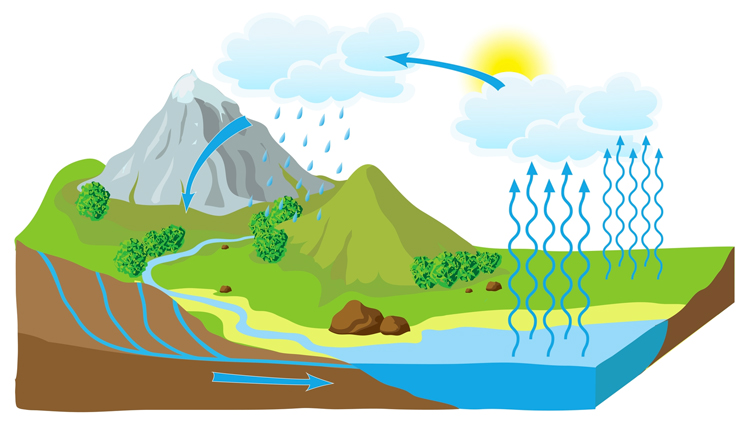They float, but they aren't made of gas. They look like cotton, but they're water. Here's everything you need to know about clouds.
A cloud is a large mass of tiny liquid water droplets and/or ice crystals of random shapes and sizes.
But how do clouds form? The cloud formation process is relatively easy to explain and understand.
When the sun warms the planet and heats oceans, rivers, lakes, and other water bodies at ground level, water vapor rises away from the surface of the Earth.
As it moves up, it gets colder, and water vapor gas turns into small water drops. In other words, it condenses.
Then, water droplets stick to microscopic particles of dust floating in the atmosphere.
The result is new water drops - the condensation nuclei - that are light enough to float around. Finally, they hit each other to create bigger droplets, eventually forming a cloud.
As it gets denser and denser, a cloud becomes heavy and may result in heavy rainfall. The water cycle is complete.

Weight, Duration, Speed, and Cloud 9
Clouds are not 100 percent water. They also contain salt, dust, and other particles and chemical substances.
There are ten different types of clouds, and each one can provide valuable information about current and future weather conditions.
The average weight of a cloud is 110 tonnes (242,000 pounds or 110,000 kilograms). However, during storms, it can weigh up to 500 tonnes (1,100,000 pounds or 500,000 kilograms).
Unfortunately, you may never sit or float on a cloud - it's not dense enough to hold a human being.
For example, the water density of a classic, fluffy white cumulus cloud is around 0.5 grams per cubic meter - it's too fragile, even for a feather.
Interestingly, high-performance glider pilots can "hang" on clouds for hours by taking advantage of currents of rising air in the atmosphere that keep them flying without losing altitude.
Clouds are not eternal. Actually, they're very short-lived.
They can float around above us for between four and six hours, even though some of these formations have already been reported to last up to 14 hours.
A cloud may travel thousands of miles per day before dissipating completely. Depending on the weather and altitude, it can move between 30 and 100 miles per hour.
And where do clouds form in the atmosphere? Generally speaking, low clouds form and float at around 5,000 feet (1,524 meters), while high clouds can appear at 30,000+ feet (9,144 meters).
Clouds disintegrate whenever the surrounding air warms up and transforms moisture into vapor.
What about the origin of the expression "to be on cloud 9"? Where did the name come from? The explanation is curious.
In 1896, the first edition of the International Cloud Atlas listed the cumulonimbus as number nine in the tallest cloud formations file.
The US Weather Bureau later used the classification in the 1950s, and the expression "to be on cloud 9" became a synonym for extreme happiness, joy, exhilaration, and a state of bliss, like floating on top of a cloud.

William Rankin: The Man Who Crossed A Cumulonimbus Thunderstorm Cloud
On July 26, 1959, Lieutenant Colonel William Henry Rankin, a pilot in the United States Marine Corps, became the only person to survive a cumulonimbus thunderstorm cloud.
He was flying an F-8 Crusader jet fighter when the engine failed, forcing him to eject and parachute into the cloudy and stormy skies. What time was it? 6 pm.
Rankin was not wearing a pressure suit, so he suffered immediate frostbite at -58 °F (-50 °C), decompression, and subsequent bleeding through mouth, ears, eyes, and nose, and began to vomit.
But the nightmare continued. The pilot was pounded by lightning and nearly drowned due to heavy rain while falling from the sky.
William Rankin eventually slammed into a tree 65 miles (104.6 kilometers) from his ejection point. Time: 6:40 pm. The descent took 40 minutes.
The hero survived the experience, wrote a book - "The Man Who Rode the Thunder" - and lived another 50 years.
